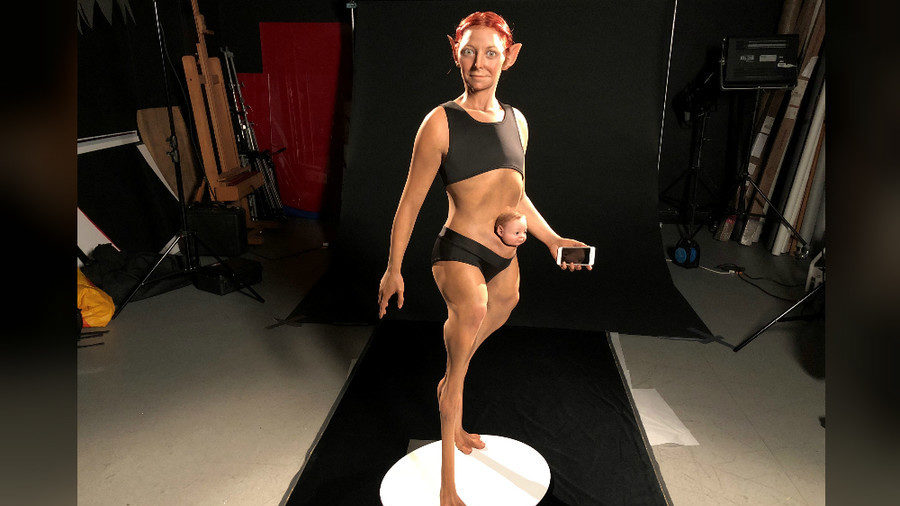
The enhanced human body created by Professor Alice Roberts and a team of designers
As walking, talking mammals, humans sit atop of the evolutionary ladder. But would life be better with emu legs, frog skin and a dog's heart? Anatomist Alice Roberts explains to RT her far-out quest for the 'perfect human body'.
The evolutionary journey from apes to the upwardly mobile and chatty homosapiens of today has been impressive but not entirely plain sailing. Cartilage in knee joints degrade with every passing decade, the heart's pulmonary arteries are open to attack from fatty plaque, while the plumbing within a human neck is a choking hazard waiting to happen.
All these design flaws are tackled in the latest project by University of Birmingham anatomist Alice Roberts in her "weird artistic" attempt to explore the evolution of the world's most complex creatures.
The result is a rather freakish looking 3D printed version of Roberts, complete with a chimp's spine, octopus refined retinas, pointed ears, and the legs of a speeding emu bird.
The scientist even had a go at re-engineering the epiglottis - a trap door protecting your windpipe from incoming food - to create a choke proof throat.
Speaking to RT.com, Roberts explained how the project - which melded 3D printing technology with attributes from the animal kingdom - began with a challenge from London's Science Museum. From there she set out upon a three-month quest which saw her essentially weed out the problems with which evolution has burdened us. The bizarre and engaging journey was chronicled in the
BBC show '
Can Science Make Me Perfect?'
With a team of experts to choose from, including 3D designer Scott Eaton, MRI experts from the Cheltenham Cobalt Imaging Center, and professionals at the Royal Veterinary Campus, Roberts' alien-looking model is astonishing.
In an effort to build an imagined body capable of withstanding harmful UV rays, Roberts even took inspiration from the skin of amphibians at London Zoo. There is also space for a marsupial pouch, included to make the birthing process more bearable since kangaroo babies come to term when they are the size of a humble jellybean.
"Essentially we were looking to iron out some of the evolutionary glitches or design flaws in the human body," Roberts said. One such human feature to get an upgrade was the heart. Since a human's blood enters into the heart from just one artery, it means the chances of a fatal blockage is high. In Roberts's 3D printed model, collateral heart vessels of a dog were suggested to combat this widespread pulmonary threat."We did end up with a weird artistic idea of what our body could be like if we were to iron out some of those glitches. I was quite surprised when I saw her [the 3D model] because I was feeding all my suggestions through to the designer and I only saw some of the early stages of the sculpture before it was unveiled."
Another striking element of the re-engineered human was the introduction of the shock absorbing pins of an emu. While not opposed to her human legs, the British anatomist explored whether having the limbs of a bird would eradicate knee pain and boost running power.
"At the heart of the artistic project was to make modifications to the human body that highlight the imperfections which have come about because we are an evolved animal," Roberts added.
"We wanted to show that the body isn't perfect. This is what evolution does, it creates organisms that perform in the here and now. Evolution is about making a body that works, it's not about perfection."
Reader Comments
R.C.
"See? We can build a 'better' 'Human' body. And if, instead of killing each other, all the world spent all its time and money on this project:
As it tried to walk, something previously unconsidered would fail, and then another, (see basic engineering); and if somehow the poor critter achieved consciousness (assuming it ever got there), it would say: "You Bastards!"
R.C.
Eugenics is the white supremacist search, seeking a solution to his recessive genes.
Fate is negotiable. Destiny is not.
Shalom
Dog heart == dramatically shortened lifespan potential.
Large ears == the easier to hear the government's propaganda.
No breasts == no longer a mammal, and thin hips + marsupial pouch, that all equates to a dramatically reduced brain size potential in offspring.. exactly what the psychopaths want for the under class...
and then emu legs.. why? just to make it even more ugly I guess.
Quite frankly aside from bigger eyes its all negative to the extreme.
That's scary.
R.C.
I just noticed this. Not 'perfect' per whose standards? The earthworms in my backyard, are 'perfect' insofar as Robins et al. are concerned.
So the description of perfect, must come from the viewpoint of a 'describer' / 'descriptor'.
Nature/God/'life seeking to extend life', has made this and THEY have placed themselves in the position of the highest and holiest. As a spiritualistic, quasi-agnostic, with a love for things that are right, and a rather meager type of hate reserved only for those who justify hate/death, I wonder "Who the f*** do you think you are?"
R.C.
Luke Holohan is it.
Who gives these fucking writers (b.s. reporters who are everywhere) their names?
Everything about this article is fucking stupid.
Just a way to generate more bogus earnings and to appear credible and earnest.
Making science fiction into science 'fact'.
What shit.
What bogus bullshit.
Building the perfect beast.
As we all should be, must be.
Duh.
ned, OUT
R.C.